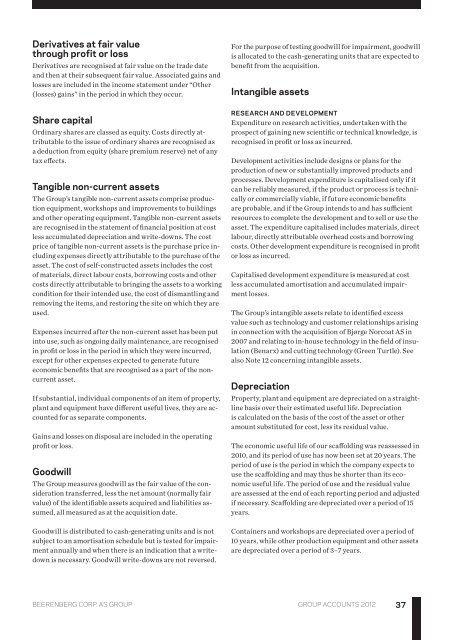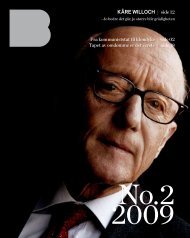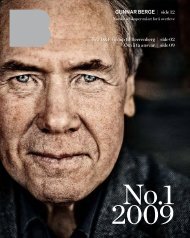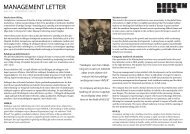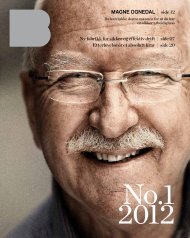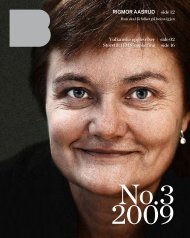Note 1 - Beerenberg
Note 1 - Beerenberg
Note 1 - Beerenberg
You also want an ePaper? Increase the reach of your titles
YUMPU automatically turns print PDFs into web optimized ePapers that Google loves.
Derivatives at fair value<br />
through profit or loss<br />
Derivatives are recognised at fair value on the trade date<br />
and then at their subsequent fair value. Associated gains and<br />
losses are included in the income statement under “Other<br />
(losses) gains” in the period in which they occur.<br />
Share capital<br />
Ordinary shares are classed as equity. Costs directly attributable<br />
to the issue of ordinary shares are recognised as<br />
a deduction from equity (share premium reserve) net of any<br />
tax effects.<br />
Tangible non-current assets<br />
The Group’s tangible non-current assets comprise production<br />
equipment, workshops and improvements to buildings<br />
and other operating equipment. Tangible non-current assets<br />
are recognised in the statement of financial position at cost<br />
less accumulated depreciation and write-downs. The cost<br />
price of tangible non-current assets is the purchase price including<br />
expenses directly attributable to the purchase of the<br />
asset. The cost of self-constructed assets includes the cost<br />
of materials, direct labour costs, borrowing costs and other<br />
costs directly attributable to bringing the assets to a working<br />
condition for their intended use, the cost of dismantling and<br />
removing the items, and restoring the site on which they are<br />
used.<br />
Expenses incurred after the non-current asset has been put<br />
into use, such as ongoing daily maintenance, are recognised<br />
in profit or loss in the period in which they were incurred,<br />
except for other expenses expected to generate future<br />
economic benefits that are recognised as a part of the noncurrent<br />
asset.<br />
If substantial, individual components of an item of property,<br />
plant and equipment have different useful lives, they are accounted<br />
for as separate components.<br />
Gains and losses on disposal are included in the operating<br />
profit or loss.<br />
Goodwill<br />
The Group measures goodwill as the fair value of the consideration<br />
transferred, less the net amount (normally fair<br />
value) of the identifiable assets acquired and liabilities assumed,<br />
all measured as at the acquisition date.<br />
Goodwill is distributed to cash-generating units and is not<br />
subject to an amortisation schedule but is tested for impairment<br />
annually and when there is an indication that a writedown<br />
is necessary. Goodwill write-downs are not reversed.<br />
For the purpose of testing goodwill for impairment, goodwill<br />
is allocated to the cash-generating units that are expected to<br />
benefit from the acquisition.<br />
Intangible assets<br />
Research and development<br />
Expenditure on research activities, undertaken with the<br />
prospect of gaining new scientific or technical knowledge, is<br />
recognised in profit or loss as incurred.<br />
Development activities include designs or plans for the<br />
production of new or substantially improved products and<br />
processes. Development expenditure is capitalised only if it<br />
can be reliably measured, if the product or process is technically<br />
or commercially viable, if future economic benefits<br />
are probable, and if the Group intends to and has sufficient<br />
resources to complete the development and to sell or use the<br />
asset. The expenditure capitalised includes materials, direct<br />
labour, directly attributable overhead costs and borrowing<br />
costs. Other development expenditure is recognised in profit<br />
or loss as incurred.<br />
Capitalised development expenditure is measured at cost<br />
less accumulated amortisation and accumulated impairment<br />
losses.<br />
The Group’s intangible assets relate to identified excess<br />
value such as technology and customer relationships arising<br />
in connection with the acquisition of Bjørge Norcoat AS in<br />
2007 and relating to in-house technology in the field of insulation<br />
(Benarx) and cutting technology (Green Turtle). See<br />
also <strong>Note</strong> 12 concerning intangible assets.<br />
Depreciation<br />
Property, plant and equipment are depreciated on a straightline<br />
basis over their estimated useful life. Depreciation<br />
is calculated on the basis of the cost of the asset or other<br />
amount substituted for cost, less its residual value.<br />
The economic useful life of our scaffolding was reassessed in<br />
2010, and its period of use has now been set at 20 years. The<br />
period of use is the period in which the company expects to<br />
use the scaffolding and may thus be shorter than its economic<br />
useful life. The period of use and the residual value<br />
are assessed at the end of each reporting period and adjusted<br />
if necessary. Scaffolding are depreciated over a period of 15<br />
years.<br />
Containers and workshops are depreciated over a period of<br />
10 years, while other production equipment and other assets<br />
are depreciated over a period of 3 –7 years.<br />
<strong>Beerenberg</strong> CORP. AS Group group accounts 2012<br />
37


